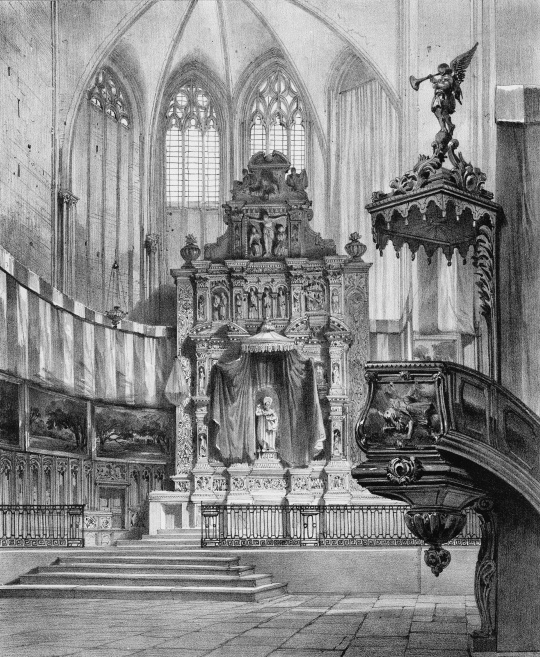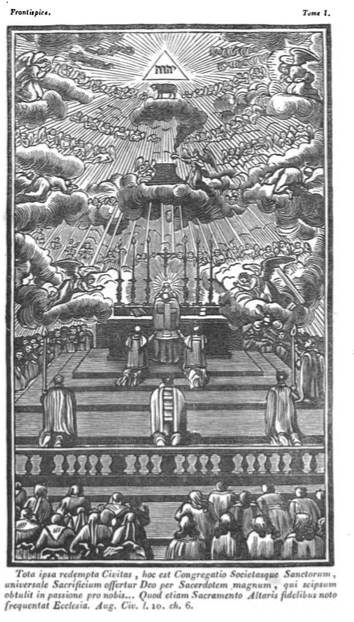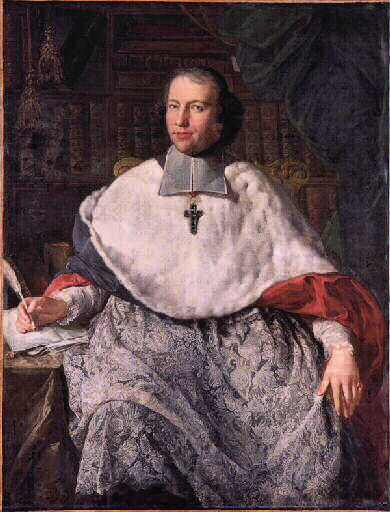As we promised in the introductory post, here are excerpts from the Preface to the first edition of volume one of Claude de Vert’s Explication simple, littérale, et historique des cérémonies de l’Église (1709 – 1713).

PREFACE
[1. Encouragement by Protestant Ministers]
It has been several years since M. Jurieu[1] undertook in one of his books to attack the ceremonies of the Mass and even to subject them to mockery. I found myself charged at that time by M. the Bishop of Meaux, and also by my own interest, to refute this minister, who had used me as a sort of witness and proof of his own ideas. Thus I wrote him a letter[2] on the subject. Since it was clear from certain places in his work that mystical and symbolic explanations were not to his taste and left no impression on him, I thought it best to accommodate myself to his dispositions. In other words, in my response the only explanations I admitted were those that were simple, natural, and historical, against which I judged M. Jurieu would have no objection. It pleased God to grant my attempt so much success, that my letter has remained without response for fifteen years.
But this is not the only effect that this manner of explaining the ceremonies of the Church has produced. It has also pleased a great number of new Catholics. Even several converted ministers were intrigued by my explanations and did me the honor of writing to say (and these are their own words):
“We have always been convinced that in order to give an account of the ceremonies of the Church, especially to new converts, one must make use of common sense, give the facts as simply as possible, and in the end explain things as naturally as possible. We have already experienced the cogency of your natural explanations with two completely opposite sorts of people, namely, with some grudging converts who saw only superstition and mummery in the Church’s rites; and with some old ecclesiastics who would hear nothing about the literal sense or about the traces of ancient customs in the liturgy, recognizing only mystery and speculation in it.”
They said that neither of these groups were able to resist my historical reasons, and the connection I made between the letter and the spirit left them speechless.
They were certain that a full discussion of all these things would be well received by both scholars and the unlettered, and even by stubborn opponents of the Church. M. Jurieu’s brief controversy had not provided the occasion for such a discussion, but the wish and need of the Church compelled me. The attempts that I had already made in my letter had given them so much pleasure that they were impatient for a complete treatment of the subject. Further, in my explanation of the Introit, Kyrie eleison, Collect, Secret, Supra quae propitio, etc., of the mingling of a part of the Host in the chalice, I had said things that no one had yet thought and that promised countless further discoveries.
Moreover these ministers plied me with innumerable questions and difficulties which they implored me to answer. And so this is the occasion and, so to speak, the foundation of the present work that I present to the public.
At the same time another ministers, one of my friends, who had also converted some years ago, but converted sincerely in good faith, through persuasion, intelligence, and knowledge, brought me one of his nephews who was still in the grips of error. […]
He was already very prejudiced against our ceremonies and especially against the exterior cult of our Religion. After having questioned me on many practices, he appeared so content with my responses (all literal and historical) that he said to his uncle (who later told me) that one more meeting with me would be enough to remove all his scruples and doubts.
[Another Successful Conversation with a Protestant Lady….]
[….]
[2. Support from Catholic Ecclesiastics]
To these proselytes, and others that I have not named, I could add a large number of Catholics: ecclesiastics and laymen of every state and personality. M. Bossuet, Bishop of Meaux especially (and all know that his name alone is synonymous with knowledge, eloquence, beauty, genius, and zeal for the Church) often did me the honor of urging me, face to face and in writing, to explain and develop all this material to its fullest extent. I did this in two or three conferences. He listened, made objections, gave counsel, and offered his advice on difficult and delicate points. I will always remember how he encouraged me not to attack the Mystical Authors or their reasons, telling me that all I had to do was lay out the facts and establish them soundly, and the truth speak for itself.
But he isn’t the only who encouraged me to work my ideas into a book. M. the Bishop of Chalons sur Saône, so well versed in this discipline, and engaged since the start of his episcopate in the correction of the usages of his church, which he is reforming wholesale and in a manner worthy of his zeal and intelligence: the Breviary, the Missal, the Ritual, and Ceremonial. After approving my Letter to the Minister Jurieu, he asked if:
“I might give a more ample, literal, and historical explanation of the ceremonies of the Mass and in general of the whole Office.”
Others told me:
“The quickest and easiest way to refute every calumny the Heretics advance against the practices of the Church is to trace them back to their origin and institution. Hence we learn the true reasons for the ceremonies, and we see their simplicity. We prove that it was necessity or utility that introduced them, and that they have been preserved either for decency or out of fear of innovation. Because the reasons are simple and natural, we see their connection to the ceremonies immediately. It has been said that the primary reason the ministers of the Protestant religion declaim against the ceremonies of the Catholic Church is that they see these ceremonies only through the mystical reasons that some Catholic authors have given to them, without seeing the natural sense that the same authors presume as the basis of everything they say.”
[…]
[On the Usefulness of this Method in Seminary Education]
M. Wateblé (who recently passed away), Superior of the seminary of Beauvais, also asked me many times to share my reflections on this question, assuring me that they would be welcomed in the seminaries of the Congregation of the Mission [….]. He said that, if he had only known these reasons a long time ago, then our seminaries would have embraced them, and this manner of explaining the ceremonies would be held in high regard. This holds as much for the priests of St. Lazare as for the Jesuits, the Fathers of the Oratory, for the congregation of St. Sulpice, and other ecclesiastics who form clergy in the seminaries. In these excellent schools, after having given the seminarians the primitive and fundamental reasons for the ceremonies, we could present them other reasons for their edification, to nourish their piety; I am referring to what I call secondary and subsidiary reasons: spiritual and symbolic ideas and pious moralities. In these holy congregations, in their frequent conferences on the practices and uses of the Church, we could develop the analogy of all these different senses and teach them to join the spirit with the letter, and figurative and allegorical explanations to literal and historical ones.
[The Catechism of Montpellier already does this]
[….]
[3. Justification for this Method from the Fathers]
In the interest of justifying this approach with examples and authorities, we see that always and in all times the practices and ceremonies of the Church have been interpreted in their proper, primitive, and necessary sense, and whenever people have understood them, they have given as far as possible simple and natural reasons in preference to those called mystical (mystiques) and figurative (figurées), and often enough even to their prejudice and exclusion. Therefore, my project is neither new nor unique. I am merely following and imitating nearly all of the authors who have ever written on this subject.
St. Jerome, for example, in his Letter to St Paulinus, St. Augustine says that the Host is broken at the Mass in order to distribute it to the faithful, ad distribuendum comminuitur. Behold: another entirely simple and natural reason for the Fraction of the Host, and very different, as we shall see, from the allegorical reasons to which the Protestants accuse us of having reduced this practice.
[Mass on Holy Thursday morning]
St. Isidore (7th c.) and the Rule of the Master written about the same time, teach us that the washing of the altars, which is still practiced today in many Churches on Holy Thursday and Good Friday is done in order to remove the dust and odors that may have collected on the tables throughout the year. In addition, they washed and purified the walls and sacred vessels, so that the whole Church was washed and set in order from the vaults to the pavement in preparation for Easter.
Amalarius, not content with the various mystical reasons given for the custom of reserving only the Body of Our Lord on Holy Thursday, without the Blood, concludes (along with the Bishop of Meaux[3]) that a more simple explanation is that this species is corrupted more easily than bread. Thus we see that this author seems to prefer this reason to the “mystical” reasons. The same author says that the priest washes his hands at Mass in order to clean and purify them from any uncleanness he may have come into contact with by touching the bread received during the Offertory. His testimony is all the more credible because Amalarius certainly cannot be accused generally of preferring simple and natural explanations. Indeed Cardinal Bona reproaches him for his excessive subtilty (quandoque nimium subtiliter). The Ordo Romanus VI, St. Thomas Aquinas, Durandus, the Jesuit P. Scortia, and others give the same reason.
[….]
[St. Thomas on the Use of Incense]
Now, what are we to make of St. Thomas’s response to the objection regarding the use of incense in the Church (this irrefragable doctor, who cannot be contradicted with impunity in the Schools of Theology, where he justly bears the excellent title of Angelic)? It is to dispel bad odors: Ut scilicet per bonum odorem depellatur si quid corporaliter pravi odoris in loco fuerit, quod posset provocare horrorem.[4] Dominic Soto, Cardinal Bellarmine, Genebrard, Scortia, Gavantus, M. Meurier, and others whom we cite later on in the work, all adopt the same reason.
[….]
[The Paschal Candle]
In the Benediction of the Paschal Candle, the Church herself teaches us that its purpose is to give light during the night: Cereus iste, in honorem nominis tui consecratus, ad noctis huius caliginem destruendam indeficiens perseveret. Thus it is left burning until the morning (flammas eius lucifer matutinus inveniat[5]).
[…]
The Council of Trent teaches us (along with the whole tradition) that water is mixed into the wine in the chalice as an imitation of Our Lord Jesus Christ who, we think, did the same: quod Christum Dominum ita fecisse credatur.[6] And why did our Lord dilute his wine at the Last Supper? Because, as St. Thomas and many theologians and scholastics tell us, it was the custom of the place to do so (secundum morem illius terrae).
[4. Conclusion]
The method we have supposed is not novel, its purpose is not unusual or surprising. Rather to the contrary, there are authors who absolutely reject every mystical reason, regarding their different applications as impractical. And the truth is that since everything in ritual and discipline is subject to perpetual change, it is quite difficult to assign mysteries to the Church’s customs and practices. Let us say, for example, that I want the chasuble, which was once entirely round and reached down to the floor, to be a symbol of charity which (according to St. Peter) covers a multitude of sins. Today this vestment is significantly shortened, trimmed and open at the sides. What possible relation could this modern garment have with the proposed mystical reason?
Or again, the Cardinal bishops were once seven in number. They could represent the seven angels or seven Churches of Asia. But now that there are only six, what can they represent? The six wings of the Seraphim? Hence the difficulty or rather the impossibility of allegorizing practices that are subject to such variation.
[….]
[Apology for Mystical Reasons]
Thus, following the understanding and taste of all these different authors, I have seen fit to explain the ceremonies of the Mass in their simple, literal, and historical sense, but with this difference, that I do not go so far as some of them. God forbid that I should ever condemn the mystic writers or mystical reasons. On this point I hold to what I said in my Letter to M. Jurieu, and to what I shall say again in the present work. To put it simply, everything I say here about historical reasons is always without prejudice to the mystical reasons. Further, even if I seem to privilege these latter, it is not that I have made my own decisions, but that I have sought the truth, and I will always be happy to learn from not only pastors and superiors, but from the littlest disciples and smallest children of the Church. Quaero non affirmo.
NOTES:
[1] A Protestant leader.
[2] https://books.google.co.il/books?id=g5xbAAAAcAAJ
[3] Communion sous les deux especes, pag. 167.
[4] De Vert omits the rest of Thomas’ response, which adds a spiritual explanation: “[The use of incense] has reference to two things: first, to the reverence due to this sacrament, i.e. in order by its good odor, to remove any disagreeable smell that may be about the place; secondly, it serves to show the effect of grace, wherewith Christ was filled as with a good odor, according to Genesis 27:27: “Behold, the odor of my son is like the odor of a ripe field”; and from Christ it spreads to the faithful by the work of His ministers, according to 2 Corinthians 2:14: “He manifesteth the odor of his knowledge by us in every place”; and therefore when the altar which represents Christ, has been incensed on every side, then all are incensed in their proper order.”
[5] Of course, even a cursory fair reading of the Exultet, with its florid descriptions of Christ as the Light of the World, and comparisons of the candle with the Pillar of Fire, would make it one of the strongest arguments against the validity of De Vert’s reductive literal sense.
[6] Again, De Vert neglects the spiritual reason given in the same chapter of Trent: “Monet deinde sancta Synodus, praeceptum esse a Ecclesia sacerdotibus, ut squam ino in calice offerendo miscerent: tum quod Christum Dominum ita fecisse credatur, tum etiam quia e latere ejus aqua simul cum sanguine exierit, quod Sacramentum hac mixtione recolitur; et cum aquae in Apocalypsi beati Joannis populi dicantur; ipsius populi fidelis cum capite Christo unio repraesentatur.”


 asically, each ceremony serves a simple, physical, hygienic convenience or reflects a simple historical accommodation. Incense dispelled bad odors. Immersion baptism was a hygienic practice meant for cleaning newborn babies. The chasuble was an ordinary Roman garment. The rood screen simply amplified a lector’s voice, a purpose just as easily achieved by a small lectern. The commixing of water and wine in the chalice is a simple imitation of historic Jewish practice. “Mystical” reasons are added later.
asically, each ceremony serves a simple, physical, hygienic convenience or reflects a simple historical accommodation. Incense dispelled bad odors. Immersion baptism was a hygienic practice meant for cleaning newborn babies. The chasuble was an ordinary Roman garment. The rood screen simply amplified a lector’s voice, a purpose just as easily achieved by a small lectern. The commixing of water and wine in the chalice is a simple imitation of historic Jewish practice. “Mystical” reasons are added later.












